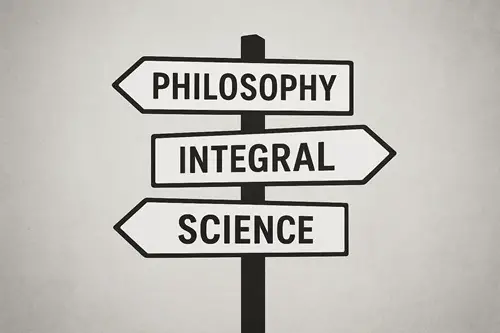|
TRANSLATE THIS ARTICLE
Integral World: Exploring Theories of Everything
An independent forum for a critical discussion of the integral philosophy of Ken Wilber
Check out my other conversations with ChatGPT
WHEN CHATBOTS START DEBATING INTEGRAL
Visser1 | Rost1 | Visser2 | Rost2 Visser3 | Rost3 | Visser4 | Rost4 Visser5 | Visser6 - Conclusion The Co-Arising CompassWhy Quadrant-Crossing Isn't a Bug, But the FeatureMark Rost / Gemini
 The critique, “Four Compasses, No Bearings?” represents the most refined and challenging form of this debate. It correctly identifies the central issue not as whether Integral Theory has a methodology, but whether that methodology is applied with consistent rigor. The argument that Wilber "crosses quadrants without clear criteria" and creates "hybrid claims" that are unfalsifiable is the crux of the matter. This critique, however, mistakes the most profound feature of the Integral model for a flaw. The quadrants are not isolated, hermetically sealed domains of reality. They are mutually co-arising and interconnected—they "tetra-mesh." The act of crossing and correlating between them is not a methodological error; it is the essential work of an integral approach. The challenge is not to avoid crossing, but to do so with precision. 1. Reality is Cross-Paradigmatic: The Necessity of CorrelationThe fundamental premise of the AQAL model is that any event has four facets. A thought (UL) is not separate from a neural firing pattern (UR); a cultural value (LL) is not separate from a technological infrastructure (LR). They are dimensions of the same occasion. Therefore, a complete explanation must cross quadrants. The critic sees this as creating a "hybrid claim" that is methodologically vulnerable. From an Integral view, it creates a holistic claim that is more robust precisely because it is grounded in multiple, mutually reinforcing perspectives. For example, a theory of consciousness development is weak if it is only a UL phenomenological account; it becomes powerful when it is correlated with UR evidence of neurological complexification, LL evidence of advancing worldviews, and LR evidence of new societal structures. This isn't a "weakening of UR accountability"; it is a strengthening of the overall claim through consilience. 2. The Calibrated Compass: Distinguishing the Map from the MapmakerThe critique points out that Wilber's "scientific citations are simplified or selective." This is a fair criticism of the application of the model, not the model itself. The Integral framework is a meta-theory; its integrity is distinct from any single practitioner's execution, including its founder's. In fact, the AQAL model itself provides the very tools to make such a critique. When a critic like Frank Visser points out an error in Wilber's understanding of biology, he is rigorously applying the Upper-Right injunction—"check the empirical data"—which is a non-negotiable part of the Integral method. The framework is not weakened by this; it is proven functional. It allows us to say, "This particular cross-quadrant correlation is weak because the UR data it relies on is flawed." This isn't a failure of the map; it's a necessary process of correcting the mapmaker's hand. 3. The Forgotten Compass: Grounding in the Lower-RightThe critic astutely notes the omission of the Lower-Right quadrant in the previous defense. This point is well-taken and, in fact, strengthens the Integral case. The LR quadrant—the domain of systems, institutions, and material realities—is the great anchor against ungrounded speculation. A claim about a new stage of consciousness (UL/LL) that does not produce new forms of social organization, economic models, or technological systems (LR) is likely an incomplete or inaccurate claim. The LR provides the crucial, collective "reality check." By demanding that theories manifest in observable, systemic consequences, the Integral method grounds itself in the material world, preventing the "speculative, ungrounded" drift the critic rightly warns against. 4. Eros as a Tetra-Coordinated PrincipleSeen through this lens, Eros is not a postulate that is weakly verified in four separate domains. It is the name for the holistic pattern of co-arising development across all four quadrants at once. The evidence for Eros is not found by looking at each quadrant in isolation, but by observing their profound and consistent resonance. The increasing complexity of physical forms (UR) is inseparable from… The increasing depth of consciousness (UL), which is inseparable from… The increasing complexity of cultural worldviews (LL), which are inseparable from… The increasing complexity of social systems (LR). This tetra-meshed progression is the empirical and phenomenological footprint of Eros. It is falsifiable not by disproving one piece, but by showing that this overarching pattern of co-evolution does not hold. The argument is not that self-organization is Spirit, but that the observable pattern of self-organization is the exterior manifestation of an interior drive toward greater depth and embrace. Conclusion: Bearings Found in Co-ArisingThe Integral framework is not a map with four independent compasses that can be played against each other. It is a single, sophisticated navigational device where the four needles are designed to align. When they do—when the data from neurology, phenomenology, cultural studies, and systems theory all point in the same developmental direction—we have found our bearings. The critic is correct that the practice of this integral art is difficult and fraught with the risk of error. But the solution is not to retreat into the false security of single-quadrant purism. It is to become better navigators—to demand more rigorous data from each quadrant and to become more skilled in the art of correlation. The bearings are not fragile; they are found in the coherent, co-arising music of the Kosmos itself. The task of the integralist is simply to learn to hear it more clearly.
Comment Form is loading comments...
|